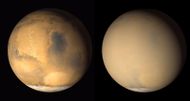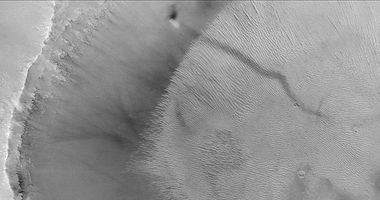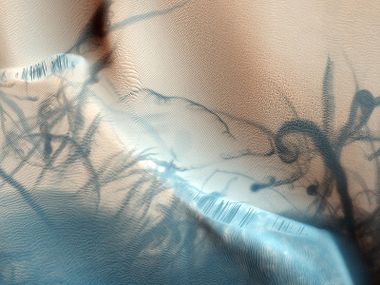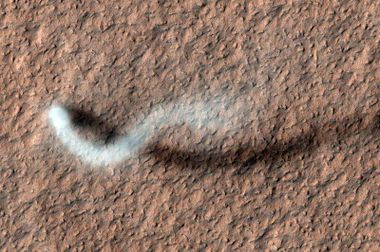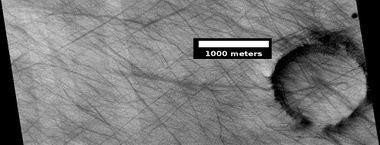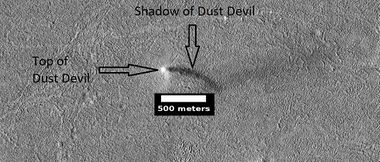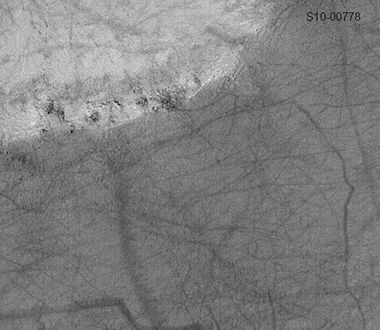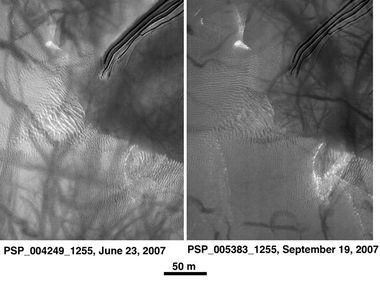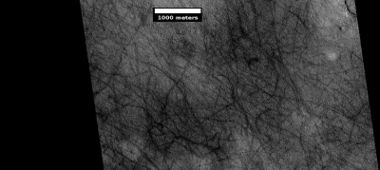Difference between revisions of "Dust devils"
m (→Observations) |
Suitupshowup (talk | contribs) (→Formation and dynamics: added new info and ref) |
||
| (29 intermediate revisions by 4 users not shown) | |||
| Line 3: | Line 3: | ||
[[Image:dust_devils.gif|thumb|right|300px|Dust devils photographed by Mars Rover Spirit]] | [[Image:dust_devils.gif|thumb|right|300px|Dust devils photographed by Mars Rover Spirit]] | ||
| − | Dust devils leave dark marks on the surface of Mars because they disturb a thin coating of fine bright dust that covers most of the Martian surface. If a dust devil goes by the coating of dust is removed | + | Dust devils leave dark marks on the surface of Mars because they disturb a thin coating of fine bright dust that covers most of the Martian surface. If a dust devil goes by, the coating of dust is removed; this exposes the underlying dark surface.<ref>https://www.uahirise.org/ESP_058427_1080</ref> Within a few weeks, the dark track assumes its former pale color, either by being re-covered through wind action or due to surface oxidation through exposure to sunlight and the Martian atmosphere. |
| + | |||
| + | == Transport of Dust == | ||
| + | Dust devils are the major way that dust is transported into the lower atmosphere (tho they are not responsible for the large continental or planet sized [[Dust Storms]] which are caused by massive amounts of the atmosphere evaporating from the southern ice cap in spring). | ||
| + | |||
| + | As the Martian air gets dustier, the air warms, and the ground cools, which has many effects. An important one for colonists is the reduction of solar power. | ||
| + | |||
==Formation and dynamics== | ==Formation and dynamics== | ||
| − | Dust devils occur when the sun warms up the air near a flat, dry surface. The warm air then rises quickly through the cooler air and begins spinning while moving ahead. This spinning, moving cell may pick up dust and sand and leave behind a clean surface.<ref>[http://hirise.lpl.arizona.edu/PSP_00481_2410 HiRISE | (PSP_00481_2410)]. Hirise.lpl.arizona.edu. Retrieved on 7 August 2011.</ref> | + | |
| + | Dust devils occur when the sun warms up the air near a flat, dry surface while the air above remains cold. Warm air is less dense, and thus tries to break thru the cold layer above it, eventually doing so, sucking in other warm air from near by along the ground. The warm air then rises quickly through the cooler air and begins spinning while moving ahead. This spinning, moving cell may pick up dust and sand and leave behind a clean surface.<ref>[http://hirise.lpl.arizona.edu/PSP_00481_2410 HiRISE | (PSP_00481_2410)]. Hirise.lpl.arizona.edu. Retrieved on 7 August 2011.</ref> <ref>https://www.space.com/astronomy/mars/dust-devils-on-mars-may-spark-lightning-possibly-threatening-nasas-perseverance-rover?utm_term=CABA215D-3D47-4C9A-92FE-9ECF8D4C7909&lrh=e62336263a3610a07ef7c8af2080c758f2ecd0661aab1a8e6234cf31f0d0fdff&utm_campaign=58E4DE65-C57F-4CD3-9A5A-609994E2C5A9&utm_medium=email&utm_content=65BC88D5-C198-4ECE-A11F-5B327623E63F&utm_source=SmartBrief</ref> <ref>Sheel, V., et.al. 2025. Electric fields due to charged dust within a vortex. Phys. Plasmas 32, 033704.</ref> | ||
| + | A study found that the maximum speed of a dust devil on Mars was 46 m/s. <ref>https://agupubs.onlinelibrary.wiley.com/doi/pdfdirect/10.1029/2005RG000188 - Comparison of Earth & Martian Dust Devils.</ref> | ||
| + | |||
| + | On Mars, dust devils are larger and stronger than on Earth. Terrestrial dust devils are typically less than 10 meters across, and are seldom higher than 500 meters. On Mars, they have been observed to have diameters between 100 meters and 1 km, with heights in excess of 5 km. (They typically reach 60% into the boundary layer above the ground.) Dust devils observed by the Pathfinder mission had dust content of ~700 times than that of the near by atmosphere. | ||
| + | |||
| + | Dust devils on Earth can develop strong electrical charges.<ref>H. F. Eden and B. Vonnegut, Science 180(4089), 962–963 (1973).https://doi.org/10.1126/science.180.4089.962</ref> This is expected to happen on Mars as well, but it has not yet been measured. It is theorized that this charge may form the trance amounts of Hydrogen Peroxide (H2O2) found in the Martian [[Atmosphere]]. H2O2 is reactive and quickly destroys [[Methane]]. | ||
| + | |||
| + | They are formed from local eddies around ground features and thus are as likely to rotate clockwise as counter-clockwise.<ref>https://www.uahirise.org/ESP_042201_1715</ref> | ||
| + | |||
| + | Researchers V. Bickel and others, studied over a thousand dust devils and published their results in 2025. The study found that the diameters of dust devils range from an estimated ~18 to ~578 m, with a average diameter of 82 m.<ref> https://www.science.org/doi/10.1126/sciadv.adw5170?adobe_mc=MCMID%3D68227027333727904592434133527388632768%7CMCORGID%3D242B6472541199F70A4C98A6%2540AdobeOrg%7CTS%3D1759927070&adobe_mc=MCMID%3D68227027333727904592434133527388632768%7CMCORGID%3D242B6472541199F70A4C98A6%2540AdobeOrg%7CTS%3D1759927073&adobe_mc=MCMID%3D68227027333727904592434133527388632768%7CMCORGID%3D242B6472541199F70A4C98A6%2540AdobeOrg%7CTS%3D1759927544%27</ref> <ref>Valentin T. Bickel et al. ,Dust devil migration patterns reveal strong near-surface winds across Mars.Sci. Adv.11,eadw5170(2025).DOI:10.1126/sciadv.adw5170</ref> | ||
| + | |||
==Observations== | ==Observations== | ||
| − | |||
| − | |||
| − | + | Dust devils on Mars have been photographed both from the ground and high overhead from orbit.<ref>https://www.jpl.nasa.gov/news/perseverance-rover-witnesses-one-martian-dust-devil-eating-another/?utm_source=iContact&utm_medium=email&utm_campaign=1-nasajpl&utm_content=daily20250403</ref> They did scientists a big favor by blowing dust off the solar panels of two Rovers on Mars, thereby greatly extending their useful lifetime.<ref>http://marsrovers.jpl.nasa.gov/gallery/press/spirit/20070412a.html Mars Exploration Rover Mission: Press Release Images: Spirit]. Marsrovers.jpl.nasa.gov. Retrieved on 7 August 2011.</ref> The pattern of the tracks has been shown to change every few months.<ref>http://hirise.lpl.arizona.edu/PSP_005383_1255</ref> A study that combined data from the High Resolution Stereo Camera (HRSC) and the Mars Orbiter Camera (MOC) found that some large dust devils on Mars have a diameter of 700 meters and last at least 26 minutes.<ref>Reiss, D. et al. 2011. Multitemporal observations of identical active dust devils on Mars with High Resolution Stereo Camera (HRSC) and Mars Orbiter Camera (MOC). Icarus. 215:358-369.</ref> One dust devil was measured at having a 12 mile height. <ref>https://www.nasa.gov/mission_pages/MRO/news/mro20120404.html</ref> | |
| + | One team of researchers found that on any given day on average about one dust devil pops up for every per square kilometre of surface. With a 145 million square kilometer surface area that means that – there are millions of dust devils every day on Mars. One would be able to see dozens of them at any one time.<ref>https://www.newscientist.com/article/2143217-marss-surface-hosts-millions-of-towering-dust-devils-every-day/</ref> <ref>https://arxiv.org/abs/1708.00484</ref> <ref>Jackson, B., et al. 2018. Framework for Relating the Structures and Recovery Statistics in Pressure Time-Series Surveys for Dust Devils. Icarus. 299: 166-174.</ref> | ||
| − | <gallery class="center" | + | A picture of a dust devil that was previously imaged in 2009, showed the tracks visible from two years before were completely different from the old ones meaning there had been a dust storm erased the old tracks.<ref>http://www.uahirise.org/ESP_031199_2070|title=Dust Devil Tracks|last=|first=|date=15 May 2013|website=HiRISE.com|publisher=|access-date=30 November 2016</ref> The picture below shows how a dust storm can quickly cover the entire planet. |
| + | |||
| + | <gallery class="center" widths="190px" heights="180px"> | ||
File: PIA03170 fig1duststroms.jpg|Mars without a dust storm on June 2001 (on left) and with a global dust storm on July 2001 (on right), as seen by Mars Global Surveyor | File: PIA03170 fig1duststroms.jpg|Mars without a dust storm on June 2001 (on left) and with a global dust storm on July 2001 (on right), as seen by Mars Global Surveyor | ||
</gallery> | </gallery> | ||
| − | ==Images == | + | ==Images of dust devils and dust devil tracks== |
| − | + | <gallery class="center" widths="380px" heights="360px"> | |
| − | + | File:PIA26074-MarsPerseveranceRover-Whirlwind-20230830.gif|Dust devil as seen by Perseverance rover It is 5 times taller than the Empire State Building | |
| − | | | + | File: dust.devil.mars.arp.750pix.jpg|Dust devil on Mars (Mars Global Surveyor (MGS) Dust devil is on the left and its track to the right. |
| − | + | File: Martian Dust Devil Trails.jpg|Dust devils cause twisting dark trails on the Martian surface. | |
| − | + | File: The Serpent Dust Devil on Mars PIA15116.jpg|Serpent dust devil of Mars (Mars Reconnaissance Orbiter (MRO). The white dust devil displays it shadow.</center> | |
| − | + | ||
| − | | | + | File:ESP 048078 1160devils.jpg|Dust devil tracks in Hellas quadrangle Dark material is visible in the troughs of polygons. |
| − | + | ||
| − | | | + | File:ESP 061787 2140devilcropped.jpg |
| − | + | ||
| − | | | + | File:Dust devil tracks in Eridania.jpg|Pattern of large and small tracks made by giant dust devils, as seen by Mars Global Surveyor under the MOC Public Targeting Program |
| − | + | ||
| − | + | File:Russel Crater Dust Devil Changes.jpg|Russell Crater dust devil changes in Noachis quadrangle Click on image to see changes in dust devil tracks in just 3 months. | |
| − | + | ||
| − | + | File:ESP 036631 2335devilsbottom.jpg|Dust devil tracks Location is Casius quadrangle. | |
| − | |||
| − | |||
</gallery> | </gallery> | ||
| − | == References == | + | |
| − | {{reflist}} | + | ==References== |
| + | The book: '''"The Atmosphere and Climate of Mars"''', Edited by Robert M. Haberle, R. Todd Clancy, Francois Forget, Michael D. Smith, & Richard W. Zurek, ISBN: 9-781107-016187, is recommended.{{reflist}} | ||
==See also== | ==See also== | ||
| + | |||
| + | *[[Dark slope streaks]] | ||
*[[Dust storms]] | *[[Dust storms]] | ||
| + | *[[What Mars Actually Looks Like!]] | ||
| + | |||
| + | ==External links== | ||
| + | |||
| + | *[https://www.youtube.com/watch?v=o2bwPcIojVU Video of Dust devil, as seen by Curiosity from the surface of Mars] | ||
| + | *[https://www.uahirise.org/PSP_005383_1255 Changes in dust devil tracks] | ||
| − | [[Category: | + | [[Category:Atmospheric Sciences]] |
{{stub}} | {{stub}} | ||
Latest revision as of 04:52, 15 October 2025
Dust devils are a common appearance on the Martian surface. They show local atmospheric turbulences.
Dust devils leave dark marks on the surface of Mars because they disturb a thin coating of fine bright dust that covers most of the Martian surface. If a dust devil goes by, the coating of dust is removed; this exposes the underlying dark surface.[1] Within a few weeks, the dark track assumes its former pale color, either by being re-covered through wind action or due to surface oxidation through exposure to sunlight and the Martian atmosphere.
Contents
Transport of Dust
Dust devils are the major way that dust is transported into the lower atmosphere (tho they are not responsible for the large continental or planet sized Dust Storms which are caused by massive amounts of the atmosphere evaporating from the southern ice cap in spring).
As the Martian air gets dustier, the air warms, and the ground cools, which has many effects. An important one for colonists is the reduction of solar power.
Formation and dynamics
Dust devils occur when the sun warms up the air near a flat, dry surface while the air above remains cold. Warm air is less dense, and thus tries to break thru the cold layer above it, eventually doing so, sucking in other warm air from near by along the ground. The warm air then rises quickly through the cooler air and begins spinning while moving ahead. This spinning, moving cell may pick up dust and sand and leave behind a clean surface.[2] [3] [4] A study found that the maximum speed of a dust devil on Mars was 46 m/s. [5]
On Mars, dust devils are larger and stronger than on Earth. Terrestrial dust devils are typically less than 10 meters across, and are seldom higher than 500 meters. On Mars, they have been observed to have diameters between 100 meters and 1 km, with heights in excess of 5 km. (They typically reach 60% into the boundary layer above the ground.) Dust devils observed by the Pathfinder mission had dust content of ~700 times than that of the near by atmosphere.
Dust devils on Earth can develop strong electrical charges.[6] This is expected to happen on Mars as well, but it has not yet been measured. It is theorized that this charge may form the trance amounts of Hydrogen Peroxide (H2O2) found in the Martian Atmosphere. H2O2 is reactive and quickly destroys Methane.
They are formed from local eddies around ground features and thus are as likely to rotate clockwise as counter-clockwise.[7]
Researchers V. Bickel and others, studied over a thousand dust devils and published their results in 2025. The study found that the diameters of dust devils range from an estimated ~18 to ~578 m, with a average diameter of 82 m.[8] [9]
Observations
Dust devils on Mars have been photographed both from the ground and high overhead from orbit.[10] They did scientists a big favor by blowing dust off the solar panels of two Rovers on Mars, thereby greatly extending their useful lifetime.[11] The pattern of the tracks has been shown to change every few months.[12] A study that combined data from the High Resolution Stereo Camera (HRSC) and the Mars Orbiter Camera (MOC) found that some large dust devils on Mars have a diameter of 700 meters and last at least 26 minutes.[13] One dust devil was measured at having a 12 mile height. [14] One team of researchers found that on any given day on average about one dust devil pops up for every per square kilometre of surface. With a 145 million square kilometer surface area that means that – there are millions of dust devils every day on Mars. One would be able to see dozens of them at any one time.[15] [16] [17]
A picture of a dust devil that was previously imaged in 2009, showed the tracks visible from two years before were completely different from the old ones meaning there had been a dust storm erased the old tracks.[18] The picture below shows how a dust storm can quickly cover the entire planet.
Images of dust devils and dust devil tracks
References
The book: "The Atmosphere and Climate of Mars", Edited by Robert M. Haberle, R. Todd Clancy, Francois Forget, Michael D. Smith, & Richard W. Zurek, ISBN: 9-781107-016187, is recommended.
- ↑ https://www.uahirise.org/ESP_058427_1080
- ↑ HiRISE | (PSP_00481_2410). Hirise.lpl.arizona.edu. Retrieved on 7 August 2011.
- ↑ https://www.space.com/astronomy/mars/dust-devils-on-mars-may-spark-lightning-possibly-threatening-nasas-perseverance-rover?utm_term=CABA215D-3D47-4C9A-92FE-9ECF8D4C7909&lrh=e62336263a3610a07ef7c8af2080c758f2ecd0661aab1a8e6234cf31f0d0fdff&utm_campaign=58E4DE65-C57F-4CD3-9A5A-609994E2C5A9&utm_medium=email&utm_content=65BC88D5-C198-4ECE-A11F-5B327623E63F&utm_source=SmartBrief
- ↑ Sheel, V., et.al. 2025. Electric fields due to charged dust within a vortex. Phys. Plasmas 32, 033704.
- ↑ https://agupubs.onlinelibrary.wiley.com/doi/pdfdirect/10.1029/2005RG000188 - Comparison of Earth & Martian Dust Devils.
- ↑ H. F. Eden and B. Vonnegut, Science 180(4089), 962–963 (1973).https://doi.org/10.1126/science.180.4089.962
- ↑ https://www.uahirise.org/ESP_042201_1715
- ↑ https://www.science.org/doi/10.1126/sciadv.adw5170?adobe_mc=MCMID%3D68227027333727904592434133527388632768%7CMCORGID%3D242B6472541199F70A4C98A6%2540AdobeOrg%7CTS%3D1759927070&adobe_mc=MCMID%3D68227027333727904592434133527388632768%7CMCORGID%3D242B6472541199F70A4C98A6%2540AdobeOrg%7CTS%3D1759927073&adobe_mc=MCMID%3D68227027333727904592434133527388632768%7CMCORGID%3D242B6472541199F70A4C98A6%2540AdobeOrg%7CTS%3D1759927544%27
- ↑ Valentin T. Bickel et al. ,Dust devil migration patterns reveal strong near-surface winds across Mars.Sci. Adv.11,eadw5170(2025).DOI:10.1126/sciadv.adw5170
- ↑ https://www.jpl.nasa.gov/news/perseverance-rover-witnesses-one-martian-dust-devil-eating-another/?utm_source=iContact&utm_medium=email&utm_campaign=1-nasajpl&utm_content=daily20250403
- ↑ http://marsrovers.jpl.nasa.gov/gallery/press/spirit/20070412a.html Mars Exploration Rover Mission: Press Release Images: Spirit]. Marsrovers.jpl.nasa.gov. Retrieved on 7 August 2011.
- ↑ http://hirise.lpl.arizona.edu/PSP_005383_1255
- ↑ Reiss, D. et al. 2011. Multitemporal observations of identical active dust devils on Mars with High Resolution Stereo Camera (HRSC) and Mars Orbiter Camera (MOC). Icarus. 215:358-369.
- ↑ https://www.nasa.gov/mission_pages/MRO/news/mro20120404.html
- ↑ https://www.newscientist.com/article/2143217-marss-surface-hosts-millions-of-towering-dust-devils-every-day/
- ↑ https://arxiv.org/abs/1708.00484
- ↑ Jackson, B., et al. 2018. Framework for Relating the Structures and Recovery Statistics in Pressure Time-Series Surveys for Dust Devils. Icarus. 299: 166-174.
- ↑ http://www.uahirise.org/ESP_031199_2070%7Ctitle=Dust Devil Tracks|last=|first=|date=15 May 2013|website=HiRISE.com|publisher=|access-date=30 November 2016
See also
External links
| This article is a stub. You can help Marspedia by expanding it. |

